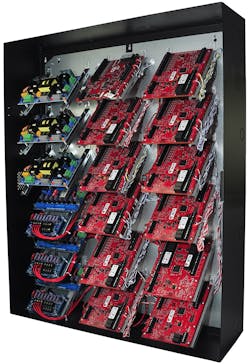The adoption of electronic locks and physical access control systems has changed the industry. The deployment of electronic access control (EAC) technology by traditional locksmiths continues to increase, and one evolving technology that continues to drive this trend is Power over Ethernet (PoE).
PoE facilitates power and data transmission over a single cable. This replaces traditional analog EAC architecture and allows the use of existing network infrastructure — Ethernet cables and devices — for system deployment. Facilities no longer must rely on the use of RS485 (serial) networks, which are notoriously difficult to service, and having localized AC power at every EAC site at a facility. Designing and powering an EAC system now is a simple plug-and-play experience.
PoE is nothing new to the physical security industry for video surveillance applications, but the number of access controllers and accessories that use PoE are trending up. New PoE technologies simplify the installation and management of EAC systems, which makes installation faster and more profitable.
The Benefits of PoE
Perhaps the biggest advantage of PoE technology is its ease of deployment. The ability to use a single Cat-6 Ethernet cable for power and data delivers extreme flexibility in the planning and installation of an EAC system.
Consequently, the placement of access controllers and ancillary devices no longer is limited by their proximity to switch cabinets and localized power sources. The process of scaling systems also has been simplified, because more devices can be added to an established network or enhanced through minimal effort.
In addition, PoE makes installations far less costly and cumbersome. Electronic locks powered by hard-wired AC power require installation by a certified electrician, which could be an added expense if your business doesn’t include one. The ability to use a PoE power solution also eliminates the necessity for that localized power supply to power locks, controllers and readers. As a result, installation can be less intrusive and not require additional high-voltage cabling, conduit to conceal and protect the wire, and permits.
High-Power PoE
These advanced solutions allow multiple 12VDC and 24VDC devices to be powered simultaneously via a 802.3bt (90 watt) PoE input. That’s more than enough power for access controllers, locking devices and peripherals.
Products now are built with EAC installation in mind, so they combine power distribution and access controllers from leading brands in one enclosure and provide power to the entire system through a single cable.
Finally, PoE-driven EAC installations generally are safer than their high-voltage alternates. Some PoE injectors carry a UL 294 listing for access control, which ensures safe, reliable operation. PoE power supplies also are intelligent and designed to protect networked equipment from overload, underpowering or incorrect installation.
Overall, upgrading or installing a PoE-based EAC system is a straightforward, secure process. By using a combination of low-voltage installation techniques and the latest PoE innovations, locksmiths can execute more-complicated installations in less time.
PoE Considerations
Although PoE is proven to be a safe, accessible and easy-to-install solution for EAC, it’s important to note that no two jobs are the same. Therefore, it’s best to approach each situation with a “most, not all” mindset and assume that the majority of the information and products that have PoE capabilities can be applied in the same way. Consider the demand and limitations of the EAC installation at hand before you apply blanket solutions.
For example, although the use of High-power PoE power supplies are sufficient for the deployment of an entire EAC system up to six doors, make sure that the devices being installed don’t exceed the power output limitation. Depending on the total power consumption of your devices and overall system, you might have to deploy multiple PoE-driven power supplies.
Because PoE switches power controllers that, in turn, power ancillary devices, such as card readers, fail-secure electric strikes or a motion request-to-exit (REX) button, the transmission of power to the connected devices is limited. Most PoE controllers have voltage limits on total power output, maxing out at about 600 milliamps. In this case, every device connected along the network’s PoE controller must be pre-screened to determine the amperage draw, so the total amperage for all components doesn’t exceed the total output limits of the controller.
PoE-driven EAC systems allow locksmiths to take advantage of the latest solutions without the necessity for additional certificates, steep learning curves, dangerous conditions or time-consuming tasks. In an industry where time is money, the cost-saving benefits of PoE solutions make EAC an attractive business opportunity for locksmiths of all stripes.
Ronnie Pennington is the director of sales for the Americas for Altronix.
About the Author
Ronnie Pennington
Ronnie Pennington is the director of sales for the Americas for Altronix.

